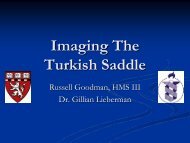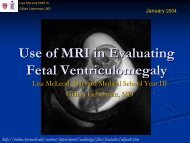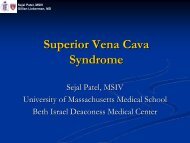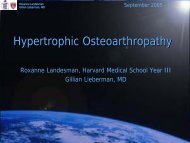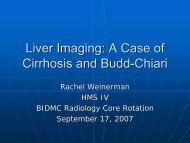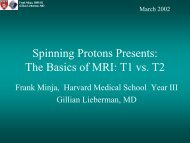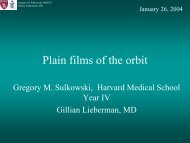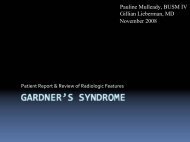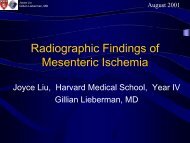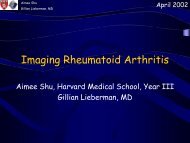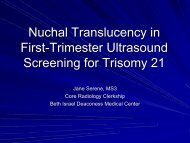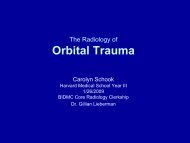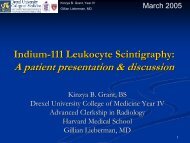Dermatomyositis and Interstitial Lung Disease - Lieberman's ...
Dermatomyositis and Interstitial Lung Disease - Lieberman's ...
Dermatomyositis and Interstitial Lung Disease - Lieberman's ...
Create successful ePaper yourself
Turn your PDF publications into a flip-book with our unique Google optimized e-Paper software.
<strong>Dermatomyositis</strong> <strong>and</strong><br />
interstitial lung disease<br />
Asmin Tulpule, HMS III<br />
November 16, 2009<br />
Core Radiology Clerkship
Agenda<br />
• Presentation of our patient<br />
• Menu of radiologic tests<br />
• Basics of interstitial lung disease (ILD)<br />
• Radiologic survey of ILD<br />
• Application of radiologic findings to our<br />
patient’s clinical course
Our patient: Initial report<br />
• Ms. L is a 57 year old F with a recent diagnosis of<br />
dermatomyositis (DM) <strong>and</strong> ILD transferred to BIDMC for<br />
worsening dyspnea <strong>and</strong> hypoxia over the past 2-3 days<br />
• Initial diagnosis of DM two months prior based on<br />
myalgias, Gottron’s papules, <strong>and</strong> heliotrope rash.<br />
Confirmed by skin biopsy.<br />
Heliotrope rash<br />
• No respiratory complaints at first <strong>and</strong> initial CT scan at<br />
OSH showed mild ILD. Started on 40 mg prednisone.<br />
http://www.jfponline.com/images/5502/5502JFP_FMGr<strong>and</strong>Rounds-fig1.jpg
Note: DM is an idiopathic inflammatory<br />
myopathy with a strong association with<br />
ILD (30-40%) characterized by pulmonary<br />
fibrosis, as well as a predisposition to<br />
developing visceral malignancies<br />
(stomach, pancreas).
Our patient: Past Medical Hx<br />
• Began developing dyspnea on exertion after a month.<br />
Thought to be progressing pulmonary fibrosis associated<br />
with DM. Receiving increasing prednisone (up to 60 mg PO<br />
qday) <strong>and</strong> started on intermittent infusions of Solumedrol.<br />
She was also tried on IVIG <strong>and</strong> azathioprine for ILD<br />
associated with DM. Her respiratory status did not<br />
improve.<br />
• She was NOT placed on any antibiotic prophylaxis<br />
• She reports night sweats for the past two months. She<br />
denies any fevers, chills, or symptoms of GI illness.<br />
• No prior history of smoking. No recent international<br />
travel history.
Our patient: Initial Evaluation<br />
• On the floor, she reports an acute 2-3 day worsening of<br />
respiratory status. She is no longer able to walk more than<br />
a few steps without developing acute shortness of breath.<br />
Physical Exam:<br />
Vital Signs: Tc 97.2 BP 117/79 HR 77<br />
RR 24 O2 sat: 93% on 6L <strong>and</strong> 70%FM<br />
GEN: Ill appearing, speaking in full sentences but<br />
appears dyspneic with conversation,<br />
occasionally stopping to catch her breath<br />
<strong>Lung</strong>s: clear anteriorly. Posterior fine crackles mid<br />
<strong>and</strong> lower lung fields. No wheezes or rhonchi.<br />
Cardiac: RRR. No m/r/g. Prominent S2
Let’s now discuss the menu of radiologic tests<br />
that could help aid us in the diagnosis <strong>and</strong><br />
management of our patient.
Agenda<br />
• Presentation of our patient<br />
• Menu of radiologic tests<br />
• Basics of interstitial lung disease (ILD)<br />
• Radiologic survey of ILD<br />
• Application of radiologic findings to our<br />
patient’s clinical course
Menu of Radiologic Tests<br />
1. Chest X-Ray (CXR), both PA <strong>and</strong> LATERAL<br />
PROS: - Excellent initial screening test<br />
- Fast <strong>and</strong> inexpensive<br />
- Sensitive for acute pulmonary processes<br />
CONS: Shows projection images – not sensitive for<br />
parenchymal detail or interstitial disease<br />
2. Chest CT (non-contrast)<br />
PROS: The gold st<strong>and</strong>ard for evaluating interstitial<br />
disease. + Contrast for pulmonary nodules<br />
<strong>and</strong> masses<br />
CONS: High cost <strong>and</strong> radiation dose. Not useful as a<br />
screening tool
Menu of Radiologic Tests cont’d<br />
Lesser Used Tests:<br />
3. Chest MR<br />
- for patients with contrast allergy or renal failure<br />
- patients who want to minimize radiation exposure<br />
(pregnant women)<br />
4. Specialized nuclear medicine testing<br />
- Gallium scan for inflammatory (sarcoidosis) or<br />
infectious processes<br />
- PET scan – monitoring of lymphoma, lung cancer
Our patient: Initial CXR w/ interstitial opacities<br />
Upright PA Chest X-ray<br />
BIDMC, PACS<br />
Always compare with<br />
prior CXR<br />
Diffuse reticular<br />
(interstitial) opacities<br />
diffusely involving both<br />
lungs, most prominent<br />
at the bases.
So, the CXR helps rule out a lot of common<br />
causes of dyspnea. We don’t see signs of a<br />
lobar pneumonia (like pneumococcal),<br />
pulmonary edema, pneumothorax, or<br />
congestive heart failure exacerbation.<br />
We are dealing with <strong>Interstitial</strong> <strong>Lung</strong> <strong>Disease</strong><br />
(aka Diffuse Parenchymal <strong>Lung</strong> <strong>Disease</strong>).<br />
What imaging test would you order next?
Our patient: Evolution of ILD on Chest CT<br />
Initial axial non-contrast<br />
chest CT on diagnosis<br />
Mild ground glass<br />
opacities at L lung base<br />
BIDMC, PACS<br />
Axial non-contrast chest CT<br />
1 month later<br />
Bilateral ground glass<br />
opacities at the bases<br />
Peripheral honeycombing
Summary of Imaging<br />
1) CXR showed diffuse bilateral reticulo-<br />
nodular opacities<br />
2) CT showed ground glass opacities <strong>and</strong><br />
honeycombing, w/o focal consolidation<br />
This is classic imaging of ILD (also known<br />
as diffuse parenchymal lung disease<br />
DPLD)
Summary of Imaging<br />
Does this tell us what our patient has?<br />
Could it be Pneumocystis carinii<br />
pneumonia (PCP) given the fact that our<br />
patient received high dose steroids without<br />
antibiotic prophylaxis?<br />
What about progressive pulmonary fibrosis<br />
associated with DM?
Can we distinguish between the different<br />
causes of ILD?<br />
Let’s review some lung anatomy…
Agenda<br />
• Presentation of our patient<br />
• Menu of radiologic tests<br />
• Basics of interstitial lung disease (ILD)<br />
• Radiologic survey of ILD<br />
• Application of radiologic findings to our<br />
patient’s clinical course
<strong>Interstitial</strong> <strong>Lung</strong> <strong>Disease</strong>s: Anatomy<br />
Alveolar unit<br />
p.a. – pulmonary artery<br />
p.v. – pulmonary vein<br />
a.s. – alveolar sac<br />
l - lymphatics<br />
http://en.wikivisual.com/images/c/ce/Alveoli.gif (Reprint from Gray’s Anatomy, 1918)<br />
ILD = Any infiltration <strong>and</strong>/or<br />
fibrosis of the lung interstitium<br />
What can do that?<br />
Cells (Immune or Malignant)<br />
Infection<br />
Fluid<br />
Fibrosis (reactive or primary)
<strong>Interstitial</strong> <strong>Lung</strong> <strong>Disease</strong>: Differential Dx<br />
Modified 2002 American Thoracic Society Guidelines for DPLD:<br />
Acute vs Chronic:<br />
Chronic:<br />
1) Known causes<br />
a) Inhaled substances: Inorganic, Silicosis, Asbestosis, Berylliosis<br />
b) Connective tissue disorders: Systemic sclerosis, Polymyositis,<br />
dermatomyositis, lupus<br />
c) Drugs: Antibiotics, Chemotherapeutic, Anti-arrhythmic drugs<br />
2) Granulomatous<br />
a) Sarcoidosis<br />
b) Hypersensitivity pneumonitis<br />
3) Rare DPLDs<br />
a) Langerhans histiocytosis<br />
b) Eosinophilic pneumonia
<strong>Interstitial</strong> <strong>Lung</strong> <strong>Disease</strong>: Differential Dx<br />
Modified 2002 ATS Guidelines for DPLD continued…<br />
4) Idiopathic <strong>Interstitial</strong> Pneumonias (IIPs)<br />
* divided pathologically<br />
a) Usual <strong>Interstitial</strong> Pneumonia (UIP) – clinical correlate Idiopathic<br />
Pulmonary Fibrosis (IPF)<br />
b) Non-Specific Intersitial Pneumonia (NSIP)<br />
c) Cryptogenic organizing pneumonia<br />
Acute:<br />
5) “Known” Infections - mimics<br />
a) Atypical pneumonia<br />
b) Pneumocystis pneumonia (PCP)<br />
c) Viral pneumonias (RSV)<br />
6) Pulmonary edema - CHF<br />
And many others....
<strong>Interstitial</strong> <strong>Lung</strong> <strong>Disease</strong>s: Anatomy<br />
www.breader.com/diagram-teaching-files/index.html<br />
Can we differentiate the<br />
different causes of ILD<br />
on CXR or CT?<br />
No. But, we can get<br />
clues as to more/less<br />
likely etiologies.<br />
Examples:<br />
a) NSIP vs UIP – no<br />
honeycombing in NSIP<br />
b) Hilar adenopathy –<br />
sarcoid vs lymphoma<br />
vs tumor
So, imaging can provide us with some<br />
insight into the different causes of ILD.<br />
Let’s take a look at some companion<br />
patients with classic findings within the<br />
broader category of ILD.
Agenda<br />
• Presentation of our patient<br />
• Menu of radiologic tests<br />
• Basics of interstitial lung disease (ILD)<br />
• Radiologic survey of ILD<br />
• Application of radiologic findings to our<br />
patient’s clinical course
Companion patient #1: Systemic Sclerosis on CXR<br />
Upright PA Chest X-ray<br />
BIDMC, PACS<br />
Diffuse reticulo-nodular<br />
(interstitial) opacities<br />
diffusely involving both<br />
lungs, perhaps R>L, most<br />
prominent at the bases.<br />
Looks similar to our<br />
patient’s CXR, though less<br />
severe !
Companion patient #1: Systemic Sclerosis on CT<br />
Axial non-contrast chest CT<br />
BIDMC, PACS<br />
Ground glass opacities<br />
noted at the lung bases<br />
Traction<br />
bronchiechtasis due to<br />
fibrous tissue tethering<br />
of the airways
Companion patient #2: Idiopathic <strong>Interstitial</strong> Pneumonia on CXR<br />
Upright PA Chest X-ray<br />
BIDMC, PACS<br />
<strong>Lung</strong> bases show fine<br />
reticulation <strong>and</strong> small<br />
nodules.<br />
Smaller number of tiny<br />
nodules are also suggested<br />
in the upper lobes<br />
Better evaluated with the<br />
chest CT to determine<br />
whether there is a fibrotic<br />
honeycombing <strong>and</strong> to<br />
assess<br />
nodules, if any.<br />
Why?<br />
Fine reticular on CXR =<br />
UIP or NSIP
Companion patient #2: Idiopathic <strong>Interstitial</strong> Pneumonia on CT<br />
Axial non-contrast chest CT<br />
BIDMC, PACS<br />
Diffuse ground-glass<br />
changes throughout<br />
the lower lobes<br />
bilaterally<br />
No honeycombing.
Honeycombing: Recall our patient<br />
Axial non-contrast chest CT<br />
Peripheral honeycombing<br />
BIDMC, PACS
Companion patient #2: Idiopathic <strong>Interstitial</strong> Pneumonia on CT<br />
Axial non-contrast chest CT<br />
BIDMC, PACS<br />
The combination of fine<br />
reticular opacities on<br />
CXR, with ground glass<br />
opacities in the<br />
absence of<br />
honeycombing on CT,<br />
helps to narrow the<br />
differential.<br />
Most likely due to<br />
fibrosing type NSIP
Companion patient #3: Sarcoidosis on CXR<br />
Upright PA Chest X-ray<br />
BIDMC, PACS<br />
Diffuse small discrete<br />
<strong>and</strong> confluent nodular<br />
opacities of varying<br />
sizes, involving both<br />
lungs.<br />
Bilateral hilar <strong>and</strong> right<br />
paratracheal soft tissue<br />
prominence,<br />
corresponding to the<br />
known adenopathy
Companion patient #3: Sarcoidosis on CT<br />
Axial non-contrast chest CT<br />
BIDMC, PACS<br />
Extensive progression<br />
of parenchymal<br />
ground glass <strong>and</strong><br />
micronodular<br />
opacities with a<br />
peribronchovascular<br />
<strong>and</strong> perilymphatic<br />
distribution consistent<br />
with worsening<br />
pulmonary<br />
sarcoidosis. No<br />
significant fibrosis.
We have taken a look at a number of<br />
different patients with classic findings of<br />
ILD that suggest a specific cause.<br />
Now, lets apply what we have learned<br />
about ILD to our patient.
Agenda<br />
• Presentation of our patient<br />
• Menu of radiologic tests<br />
• Basics of interstitial lung disease (ILD)<br />
• Radiologic survey of ILD<br />
• Application of radiologic findings to our<br />
patient’s clinical course
Upright PA Chest X-ray<br />
Recall our patient<br />
BIDMC, PACS<br />
Axial non-contrast chest CT<br />
Combining the radiologic findings <strong>and</strong> clinical history,<br />
can we narrow our differential of ILD causes?
Recall the Differential Dx for ILD<br />
1) Known causes<br />
a) Inhaled substances: Inorganic, Silicosis, Asbestosis, Berylliosis<br />
b) Connective tissue disorders: Systemic sclerosis, Polymyositis,<br />
dermatomyositis, lupus<br />
c) Drugs: Antibiotics, Chemotherapeutic, Anti-arrhythmic drugs<br />
2) Granulomatous<br />
a) Sarcoidosis<br />
b) Hypersensitivity pneumonitis<br />
3) Rare DPLDs<br />
4) Idiopathic <strong>Interstitial</strong> Pneumonias (IIPs) * divided pathologically<br />
a) UIP – clinical correlate IPF<br />
b) NSIP<br />
5) “Known” Infections - mimics<br />
a) Atypical pneumonia<br />
b) Pneumocystis pneumonia (PCP)<br />
c) Viral pneumonias (RSV)
Basics of PCP pneumonia<br />
Most common cause of interstitial pneumonia in<br />
immunocompromised patients (AIDS, high dose steroids,<br />
chemotherapy)<br />
Imaging:<br />
Normal CXR (10-40%)<br />
Often starts out as bilateral reticular infiltrates<br />
Rapidly continues to diffuse airspace disease<br />
Classic CT finding:<br />
- Exudative alveolitis w/ accumulation of fluid, organisms,<br />
fibrin, debris in alveolar spaces ground glass opacity<br />
- Patchy, mosaic appearance of diseased lung next to<br />
normal
Basics of PCP pneumonia<br />
Diagnosis: Sputum or BAL – confirmed in our patient<br />
Clinical Course:<br />
Started on high dose bactrim.<br />
Usually responds to bactrim therapy in 5-7 days. Very low<br />
levels of resistance.<br />
Redistribution of infection to upper lobes<br />
Complications:<br />
Cystic lung disease<br />
Spontaneous pneumothorax, frequently bilateral (6-7%)<br />
Or…..
2<br />
Our patient: Worsening CXR on Day 11<br />
1<br />
Upright PA Chest X-ray<br />
3<br />
(1) Endotracheal tube<br />
(2) PICC<br />
(3) Nasogastric tube<br />
Findings:<br />
Pneumopericardium<br />
Pneumomediastinum<br />
Small R apical pneumothorax.<br />
Slight increased opacity<br />
projecting over the mid right<br />
lung field may represent<br />
atelectasis versus early<br />
consolidation.<br />
BIDMC, PACS
Our Patient: Progression of ILD on CT<br />
Axial non-contrast chest CT<br />
BIDMC, PACS<br />
Diffuse central <strong>and</strong><br />
peripheral ground-glass<br />
opacification, with new<br />
involvement of the basal<br />
segments of the left lower<br />
lobe with atelectasis.
Our patient: Outcome<br />
Very sadly, after being on the ventilator for 17 days, our<br />
patient passed way on 9/14/09.<br />
The final conclusion is that the cause of death was diffuse<br />
alveolar damage associated with pneumocystis<br />
pneumonia.
Summary<br />
1) When giving high dose steroids, always prophylax<br />
against opportunistic infections.<br />
2) CXR is a great screening tool for identifying ILD, but<br />
does not provide many specific clues about etiology.<br />
Always consider the first key branchpoint: acute vs<br />
chronic process?<br />
3) Hi-resolution CT scan provides parenchymal detail <strong>and</strong><br />
can identify patterns to narrow the ILD differential<br />
(honeycombing, ground glass). However, pathology,<br />
microbiology <strong>and</strong> other studies are almost always<br />
needed to confirm a diagnosis.
References<br />
Spectrum of fibrosing diffuse parenchymal lung disease.<br />
Morgenthau AS, Padilla ML. Mt Sinai J Med. 2009 Feb;76(1):2-23.<br />
Diagnosis of interstitial lung diseases. Ryu JH, Daniels CE, Hartman<br />
TE, Yi ES. Mayo Clin Proc. 2007 Aug;82(8):976-86.<br />
Imaging features of Pneumocystis carinii pneumonia. Crans CA Jr,<br />
Boiselle PM. Crit Rev Diagn Imaging. 1999 Aug;40(4):251-84. Review.<br />
ATS/ERS international multidisciplinary consensus classification of<br />
the idiopathic interstitial pneumonias. Demedts M, Costabel U. Eur<br />
Respir J. 2002 May;19(5):794-6.
Erine Yeh<br />
David O’Donnell<br />
Maria Levantakis<br />
Gillian Lieberman<br />
Acknowledgements



